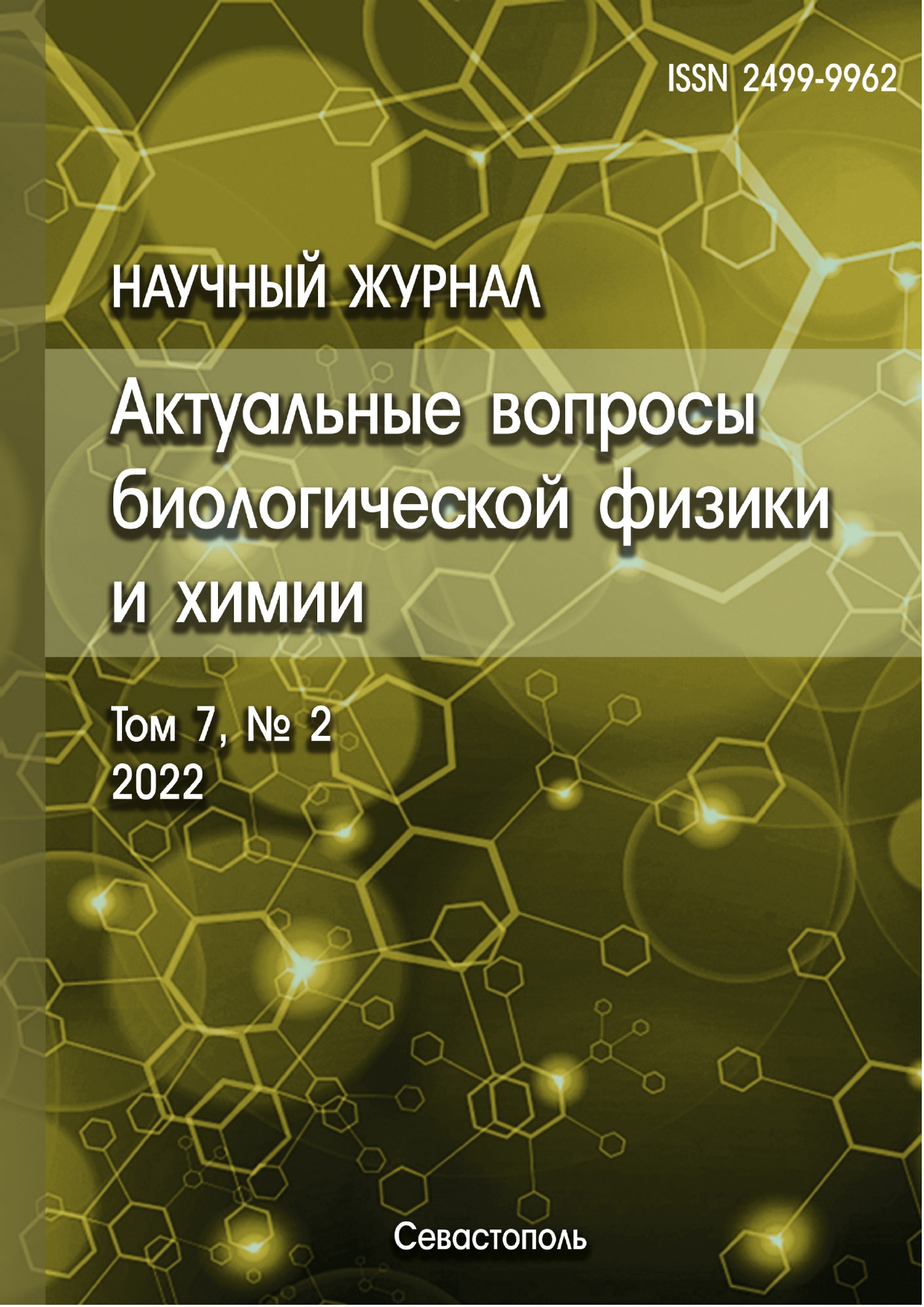Vladivostok, Vladivostok, Russian Federation
Vladivostok, Vladivostok, Russian Federation
Vladivostok, Vladivostok, Russian Federation
Vladivostok, Vladivostok, Russian Federation
Vladivostok, Vladivostok, Russian Federation
Vladivostok, Vladivostok, Russian Federation
Vladivostok, Vladivostok, Russian Federation
Vladivostok, Vladivostok, Russian Federation
Vladivostok, Vladivostok, Russian Federation
Vladivostok, Vladivostok, Russian Federation
The paper considers the process of formation and properties of amyloid-like aggregates of outer membrane non-specific porins (OmpC and OmpF) of the gram-negative bacterium Yersinia pseudotuberculos in an acidic medium (pH 4.5) at elevated temperature. The dynamics of the formation of amyloid-like aggregates of porins was monitored after two and four weeks of incubation (at 42 °C) and after 3-5 hours (at 90 °C) by staining the samples with amyloid-specific dye thioflavin T, analyzing the spectra of circular dichroism in the far UV region, IR -spectroscopy and confocal microscopy. It was found that in the case of porin OmpC, incubation under mild conditions (42°C) leads to a reversible accumulation of α-helical regions in the protein polypeptide chain. No significant changes are observed in the spatial structure of OmpF porin under these conditions, however, under harsh conditions (95 ºC) amyloid-like aggregates are formed, which are characterized by an increased content of the β-sheet structure. Using IR spectroscopy, it was shown that the conformational rearrangement in the molecule of OmpF porin is associated with a change in the quantity and quality of elements of the β-structure. According to confocal microscopy, the aggregates of the studied non-specific porins can be considered as intermediate products of the amyloidogenic pathway - oligomers. According to the literature data, these oligomers, which precede the formation of mature fibrils, have membranolytic and cytotoxic properties. For heated samples of the studied porins during reconstitution into bilayer lipid membranes, neither pore-forming nor membranolytic activity was detected. With respect to Neuro-2a CCL-131™ mouse neuroblastoma cells, the aggregates of OmpF and OmpC porins obtained after incubation had a higher toxicity compared to the initial protein samples.
porins of gram-negative bacteria, oligomers, amyloid fibrils, interaction with thioflavin T, cytotoxic activity
1. Uversky V. Unusual biophysics of intrinsically disordered proteins. Biochimica et Biophysica Acta (BBA), 2013, vol. 1834, no. 5, pp. 932-951, doi:https://doi.org/10.1016/j.bbapap.2012.12.008. EDN: https://elibrary.ru/RFDTGT
2. Oates M.E., Romero P., Ishida T., Ghalwash M., Mizianty M.J., Xue B., Dosztanyi S., Uversky V.N., Obradovic Z., Kurgan L., Dunker A.K., Gough J. D2P2: Database of Disordered Protein Predictions. Nucleic Acids Research, 2013, vol. 41, no. D1, pp. D508-D516, doi:https://doi.org/10.1093/nar/gks1226. EDN: https://elibrary.ru/RFGBDR
3. Dass R., Mulder F.A.A. Nielsen J.T. ODiNPred: comprehensive prediction of protein order and disorder. Sci. Rep., 2020, vol. 10, p. 14780, doi:https://doi.org/10.1038/s41598-020-71716-1. EDN: https://elibrary.ru/ASBJDW
4. Novikova O.D., Uversky V.N., Zelepuga E.A. Non-specific porins of Gram-negative bacteria as proteins containing intrinsically disordered regions with amyloidogenic potential. Progress in Molecular Biology and Translational Science, 2021, vol. 183, no. 3, doi: 10.1016/ bs.pmbts.2021.06.012. DOI: https://doi.org/10.1016/bs.pmbts.2021.06.012; EDN: https://elibrary.ru/YXQPLG
5. Sahaya Rajan J.J., Chinnappan Santiago T., Singaravel R., Ignacimuthu S. Outer membrane protein C (OmpC) of Escherichia coli induces neurodegeneration in mice by acting as an amyloid. Biotechnol. Lett, 2016, vol. 38, doi:https://doi.org/10.1007/s10529-015-2025-8.
6. Kosolapova A.O., Belousov M.V., Sulatskaya A.I. et al. Two novel amyloid proteins, RopA and RopB, from the root nodule bacterium Rhizobium leguminosarum. Biomolecules, 2019, vol. 9, doi:https://doi.org/10.3390/biom9110694. EDN: https://elibrary.ru/OMMORI
7. Nilsson M.R. Techniques to study amyloid fibril formation in vitro. Methods, 2004, vol. 34, no. 1, pp. 154-160, doi:https://doi.org/10.1016/j.ymeth.2004.03.012. EDN: https://elibrary.ru/MDIFDD
8. Zandomeneghi G., Krebs M.R.H., Mccammon M.G., Fändrich M. FTIR reveals structural differences between native -sheet proteins and amyloid fibrils. Protein Science, 2004, vol. 13, doi:https://doi.org/10.1110/ps.041024904.
9. Laurine E., Gregoire C., Fandrich M., Engemann S., Marchal S., Thion L., Mohr M., Monsarrat B., Michel B., Dobson C.M. Lithostathine quadruple-helical filaments form proteinase K-resistant deposits in Creutzfeldt-Jakob disease. J. Biol. Chem, 2003, vol. 278, doi:https://doi.org/10.1074/jbc.M306767200. EDN: https://elibrary.ru/LMLMOJ
10. Goormaghtigh E., Cabiaux V., Ruysschaert J.-M. Determination of soluble and membrane protein structure by Fourier transform infrared spectroscopy. In Physicochemical Methods in the Study of Biomembranes; Springer: New York, NY, USA, 1994, vol. 23, doi:https://doi.org/10.1007/978-1-4615-1863-1_10.
11. Dobson C.M. Protein folding and misfolding. Nature, 2003, vol. 426, doi:https://doi.org/10.1038/nature02261.
12. Lashuel H.A., LaBrenz S.R., Woo L., Serpell L.C. Kelly J.W. Protofilaments, filaments, ribbons, and fibrils from peptidomimetic self-assembly: implications for amyloid fibril formation and materials science. Am. Chem. Soc, 2000, vol. 122, doi:https://doi.org/10.1021/ja9937831.
13. Nilsberth C., Westlind-Danielsson A., Eckman C.B., Condron, M.M., Axelman K., Forsell C., Stenh C., Luthman J., Teplow D. B., Younkin S. G., Naslund J., Lannfelt L. The "Arctic" APP mutation (E693G) causes Alzheimer's disease by enhanced Abeta protofibril formation. Nat. Neurosci, 2001, vol. 4, doi:https://doi.org/10.1038/nn0901-887.
14. Bucciantini M., Giannoni E., Chiti F., Baroni F., Formigli L., Zurdo J., Taddei N., Ramponi G., Dobson C.M., Massimo S. Inherent toxicity of aggregates implies a common mechanism for protein misfolding diseases. Nature, 2002, vol. 416, doi:https://doi.org/10.1038/416507a.
15. Walsh D.M., Klyubin I., Fadeeva J.V., Cullen W.K., Anwyl R., Wolfe M.S., Rowan M.J., Selkoe D.J. Naturally secreted oligomers of amyloid beta protein potently inhibit hippocampal long-term potentiation in vivo. Nature, 2002, vol. 416, doi:https://doi.org/10.1038/416535a.
16. Campioni S., Mannini B., Zampagni M., Pensalfini A., Parrini C., Evangelisti E. A causative link between the structure of aberrant protein oligomers and their toxicity. Nat. Chem. Biol, 2010, vol. 6, doi:https://doi.org/10.1038/nchembio.283. EDN: https://elibrary.ru/NYXHXT
17. Patel P., Parmar K., Patel D., Kumar S., Trivedi M., Das M. Inhibition of amyloid fibril formation of lysozyme by ascorbic acid and a probable mechanism of action. Int. Journal Biol. Macromol., 2018, vol. 114, doi:https://doi.org/10.1016/j.ijbiomac.2018.03.152.










